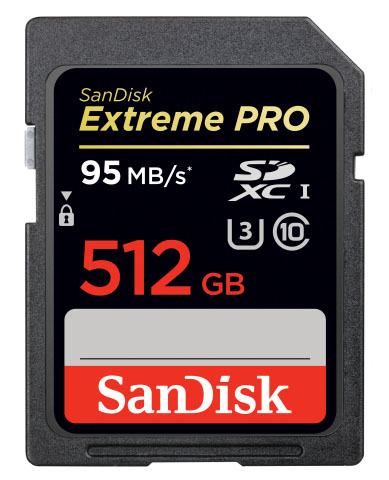SanDisk Launches Extreme PRO SD Cards: Up to 512GB
by Kristian Vättö on September 11, 2014 3:38 PM EST- Posted in
- Storage
- SanDisk
- SD cards
- Extreme Pro

While we don't usually cover SD cards, SanDisk's announcement of 512GB Extreme PRO SD card caught my eye today. There are currently only a couple of 256GB SD cards available and most OEMs have not been able to go above 128GB, so the Extreme PRO is the highest capacity SD card in the world, which really speaks for SanDisk's NAND and packaging expertise.
| SanDisk Extreme PRO SDXC UHS-I Memory Card Specifications | |||||||||
| Capacities | 128GB, 256GB & 512GB | ||||||||
| Read Speed | Up to 95MB/s | ||||||||
| Write Speed | Up to 90MB/s | ||||||||
| Warranty | Lifetime Limited | ||||||||
The Extreme PRO comes in SDXC format and utilizes UHS-I interface, which is good for up to 104MB/s. As you can see in the table above, the Extreme PRO comes very close to saturating the interface and it carries UHS Speed Class 3 rating, meaning that it is suitable for capturing 4K video. The largest market for the new Extreme PRO SD cards is obviously video professionals because as we transition to 4K video, the need for storage increases substantially, which in turn opens market for larger SD cards.
While SanDisk didn't release any details of the internals, it's pretty safe to assume that the 512GB Extreme PRO consists of 32 x 128Gbit (16GB) dies. The photo above is from SanDisk's 2014 Investor Day presentation where the company claimed that it has the technology for a 32-die SDXC card and with the Extreme PRO the technology has made it into the retail. Since SanDisk/Toshiba doesn't have a 256Gbit NAND die (nobody has one in mass production yet), the only way to achieve 512GB is through a 32-die stack. SanDisk hasn't specified whether the NAND is MLC or TLC, but given that it is a high-end product I'm guessing it is MLC based.
EDIT: As some of you mentioned in the comments, it seems to be two 16-die stacks instead of a single 32-die stack. SD cards definitely have the room for two die stacks and the photo also shows two 16-die stacks instead of a single 32-die stack. Either way it is impressive since nothing else comes close to the capacity SanDisk offers.
All capacities are available now and the MSRP for the 512GB model is $800, which is certainly high since 512GB SSDs retail for close to $200. However, the Extreme PRO is the only SD card that is available in such a high capacity, so I would say the premium is justified. Stacking more dies on top of each other will always have a negative impact on yield as the wires have to be longer and there are more wires to connect, so the room for errors increases and thus the manufacturing cost goes up as well.











54 Comments
View All Comments
MrSpadge - Friday, September 12, 2014 - link
Thanks!CharonPDX - Thursday, September 11, 2014 - link
At 128 GB and higher, most cards are the newer SDXC, not SDHC. Anything that says it has SDXC support should work. (And as someone else said, these are full-size SD, not micro, so no current smartphones need apply. These are for cameras.)pixelstuff - Thursday, September 11, 2014 - link
Pretty sure SDHC is limited to 32GB. Any SD card larger than 32GB is by default SDXC.shadowjk - Friday, September 12, 2014 - link
The biggest difference between SDHC and SDXC is the filesystem. The filesystem has microsoft tax attached. The SD standards specify the filesystem you must support. So, even if your device could use SDXC with fat32,ntfs, ext4, or any other filesystem, you aren't allowed to claim you support anything bigger than 32g.My asus android tablet seems to work fine with 64gig cards, as long as they're not exfat. Even ntfs works.
mkozakewich - Friday, September 12, 2014 - link
Yeah, people are stupid when they say "You can put up to 128 GB of extra storage with microSD." What they mean is, "You could get a 128 GB microSD card today."microSDXC goes up to 2 TB. I remember seeing the mockup of a 2TB microSD card a few years ago, to go with that announcement. It was completely ludicrous at the time, but all we need now is two more doublings.
Silverbullet126 - Thursday, September 11, 2014 - link
Something along the lines of 'all the eggs in one basket' comes to mind when I see cards this big. Would be really bad to loose that much data of photos or video.p1esk - Thursday, September 11, 2014 - link
512GB only holds about 1 hour of compressed 4k/60 video.extide - Thursday, September 11, 2014 - link
Depends on the compression... I mean you can easily get 1 hour in far less than 512GB (and have it still look good). Now.. uncompressed, lol yeah you would be talking tens of minutes, or less. Yikes!Samus - Thursday, September 11, 2014 - link
128GB (the industry standard) holds 80 minutes of 1080P/60 video, so losing 14 minutes of recording time is somewhat manageable when your alternative, up until now, was 33 minutes for 4k/60 (on uncommon 256GB cards) or, *caugh* 16 minutes on 128GB cards.DanNeely - Thursday, September 11, 2014 - link
4k video devours storage though. A bit of Googling turned up cameras recording at 150MB/sec on XQD cards (looked like a CF successor for high end systems) for 4k60. This card's not fast enough to match that; but it should be able to comfortably do half that and 75MB/sec is 287GB/hour. So this card as expensive and huge as it is can still only hold a few hours of 4k video.